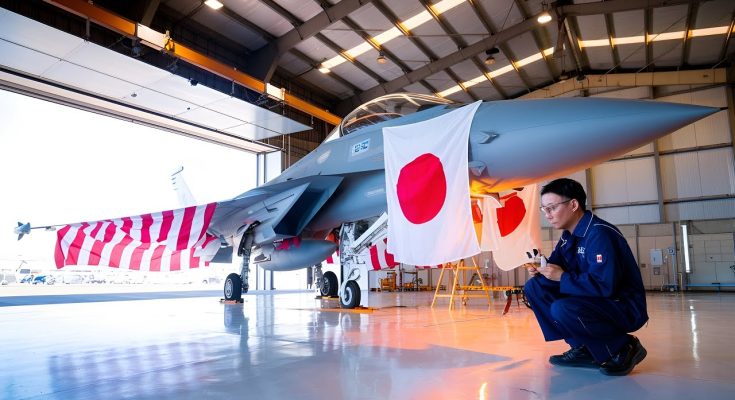Japanese Tech Made That Even Better: The Mitsubishi F-15J
The Mitsubishi F-15J is a Japanese variant of the American-made McDonnell Douglas F-15 Eagle, one of the most successful air superiority fighters in the world. While the F-15J retains much of the core design and performance characteristics of its American predecessor, the Japanese version has been enhanced with indigenous technology to meet the specific needs of Japan’s Self-Defense Forces (JSDF) and its unique operational requirements. These modifications have resulted in an aircraft that combines the proven capabilities of the F-15 platform with cutting-edge Japanese technology, making the F-15J one of the most advanced and reliable air superiority fighters in the world.
The F-15J: A Brief Overview
The F-15J was introduced into the Japan Air Self-Defense Force (JASDF) in the 1980s and is primarily used for air superiority, interception, and defensive operations. Built by Mitsubishi Heavy Industries under license from McDonnell Douglas, the F-15J is largely based on the F-15C, which is a single-seat, all-weather air superiority fighter. The F-15J retains the same powerful Pratt & Whitney F100-PW-229 engines, dual-engine configuration, and rugged airframe that have made the F-15 a formidable aircraft for decades.
One of the core strengths of the F-15J is its ability to perform long-range, high-speed intercepts, making it ideal for defending Japan’s airspace against potential threats. The aircraft is equipped with a powerful radar and sophisticated avionics, but the key to the F-15J’s effectiveness lies in the Japanese-made upgrades that have been integrated into the platform.
Japanese Technology Enhancements
While the F-15J shares many similarities with its American counterpart, Mitsubishi’s contribution to the aircraft’s design has resulted in several notable upgrades. Some of the most important enhancements include modifications to the radar system, avionics, and weaponry, which make the F-15J uniquely suited to Japan’s specific defense needs.
1. Advanced Radar Systems
The original F-15 radar was upgraded to a Japan-specific, indigenously developed system known as the J/APG-1 radar. This system offers improved range and detection capabilities, allowing the F-15J to identify and track multiple targets simultaneously in all weather conditions. The enhanced radar also provides better resolution and a broader field of view, which gives the F-15J superior situational awareness in a combat environment. Japan’s emphasis on technology ensures the radar is effective in the complex and challenging Pacific theater.
2. Avionics Upgrades
Another key area of improvement for the F-15J is the avionics system. The cockpit has been upgraded with modern displays, which provide pilots with more intuitive and efficient interfaces for mission planning and execution. The new avionics system integrates advanced data link technology, allowing the F-15J to communicate and share information with other assets in the battlefield network, such as ground stations, surveillance aircraft, and other fighters.
Moreover, Japan has integrated its own electronic warfare (EW) systems into the F-15J, improving its ability to evade detection and disrupt enemy radar and communication systems. These EW systems are crucial for enhancing survivability in contested environments, where advanced radar and missile systems are a significant threat.
3. Weaponry and Payload
While the F-15J retains the versatile weapon loadout of the original F-15, Japan has adapted its own weapons to suit the regional security environment. The aircraft is capable of carrying a wide array of air-to-air and air-to-ground munitions, such as the AIM-7 Sparrow and AIM-120 AMRAAM missiles, which enhance the aircraft’s air superiority capabilities. Japan has also developed its own ground-attack munitions for the F-15J, allowing the fighter to perform a broader range of missions, including precision strikes against enemy ground targets.
Additionally, Japan has adapted the F-15J for extended-range operations by incorporating external fuel tanks and improving the aircraft’s aerial refueling capabilities, allowing it to operate over vast distances, crucial in the Pacific region where Japan’s defense perimeter is extensive.
Operational Role and Effectiveness
The Mitsubishi F-15J serves as the cornerstone of Japan’s air defense strategy. It is a key asset in the country’s defense against potential threats from regional adversaries, including North Korea and China. The F-15J is designed to operate in concert with other modern aircraft, such as the F-35A stealth fighter, to provide a layered defense strategy.
The F-15J plays an integral role in Japan’s air policing missions, regularly conducting intercepts of foreign aircraft that enter Japan’s airspace. The fighter also serves in joint exercises with the United States and other allied nations, where its advanced radar and communication systems allow it to integrate seamlessly into multinational operations.
The Future of the F-15J
While the F-15J remains a powerful and effective fighter, Japan’s evolving security environment and technological advances may lead to further upgrades or even a replacement in the future. The country has expressed interest in developing its own next-generation fighter, known as the F-X, which could eventually take over from the F-15J. However, for the foreseeable future, the F-15J will remain a crucial part of Japan’s air defense strategy.
In conclusion, the Mitsubishi F-15J is a testament to Japan’s technological prowess and its ability to enhance and adapt foreign designs to meet national security needs. The integration of advanced Japanese-made radar, avionics, and electronic warfare systems has made the F-15J a formidable fighter that remains highly relevant in modern aerial combat. By combining the proven F-15 platform with Japan’s cutting-edge technology, the F-15J stands as one of the most advanced and reliable fighter jets in the world today.



